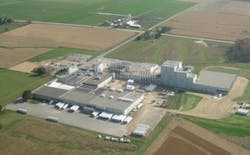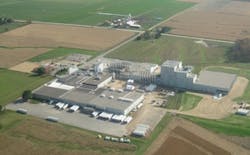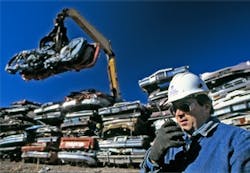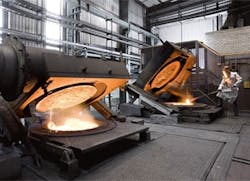2012 Best Practices Awards
The Plant Services Best Practices Awards represent the best demonstrated techniques utilized for more efficient maintenance, reliability, engineering, or production — the four pillars of plant management. The competition is open to anyone with the authority to tell a good story that includes a quantifiable metric vindicating the implementation and illustrating its success. The measurement also gives others the basis of a business case for the tool or technology, which then can be presented to senior management to obtain funding.
Our two winners both used technology to lower their costs. In each case, the company’s growth had amassed an array of technology that had spun out of control and created a web of disarray. Grassland Dairy streamlined maintenance by implementing CMMS software, while Gerdau Ameristeel integrated data from disparate controllers, historians, and reporting systems. Each story is its own best practice.
The hum of dairy machinery
Grassland Dairy saves 33% on maintenance costs with CMMS software
At Grassland Dairy (www.grassland.com) in Greenwood, Wisconsin, hundreds of gallons of cream were getting churned into butter during an ordinary day shift, until the butter machine slowed down to a crawl.
Figure 1. When production came to a halt at Grassland Dairy, Jim Hills, who had been operating the butter machine, searched the 100-acre plant until he finally found a maintenance technician to replace the worn components and get things running again.
The problem was a lack of regularly scheduled maintenance. As production ground to a halt, Jim Hills, who had been operating the butter machine, frantically searched the sprawling 100-acre plant until he finally found a maintenance technician to replace the worn components and get things running again (Figure 1).
That experience, early in his career, also led Hills on another search. He began to explore methods for improving maintenance of the dairy’s vast web of machinery. And in that process, he discovered the world of the computerized maintenance management system (CMMS) — specifically, a CMMS software program called Bigfoot, produced by the Smartware Group (www.smartwaregroup.com), which is now used to automate a variety of maintenance tasks at Grassland facilities, including a preventive maintenance (PM) scheduling system for more than 1,500 pieces of equipment, and an inventory database for 8,000-plus replacement parts.
Not only has the software streamlined maintenance at the dairy plant, Hills also credits the program with helping him move up the ranks from being a floor mechanic to his current position as assistant corporate maintenance manager.
In the past, equipment would fail because of something as simple as improper maintenance or a lack of scheduling, which resulted in oil not being added to a gearbox on a regular basis, recalls Hills. “We tried to keep track of everything on paper,” he says. “We tried meetings or simply assigning mechanics’ tasks based on memory. But within three months, all of our maintenance information would disappear. Now, we have a preventive maintenance schedule set up through Bigfoot for a wide variety of equipment, so we no longer have those kinds of problems.”
An industry powerhouse
Figure 2. Keeping the machinery humming is no small feat for Grassland’s 25-member maintenance staff in Greenwood, Wisconsin.
Keeping the machinery humming is no small feat for Grassland’s 25-member maintenance staff. The facilities include the main Greenwood plant, which covers one-fourth of a square-mile area in central Wisconsin, plus sister plants in West Point, Nebraska; Hyrum, Utah, under the West Point Dairy Products label, and Graf Creamery located in Zachow, Wisconsin (Figure 2).
Recognized as the largest privately owned dairy manufacturer in the industry, Grassland takes in milk from more than 900 local family-operated farmers. All of that milk is then transformed into a variety of dairy items such as powdered and condensed milk, as well as salted and unsalted butter products that are sold through 300 private labels.
Strict USDA guidelines for sanitation and food safety pose a particular challenge in the dairy industry, which must be vigilant in combatting bacterial contamination from E.coli, listeria, and other pathogens. Hills says the Bigfoot system has been instrumental in helping his department meet that challenge by simplifying maintenance of Grassland’s two central testing labs and its array of testing equipment, which include not only water ionizers, water filtration systems, and air quality systems, but also metal detectors to monitor products for incidental foreign objects.
{pb}The data provided by Bigfoot also gives Hills quick access to the information his customers require for numerous quality assurance (QA) plant audits. “Lab personnel pull samples constantly,” says Hills, “because all of our products are heavily monitored through QA. I’ve been in a lot of different plants and have seen some that are not as clean as they should be. But Grassland’s is spotlessly clean. I would eat off the floor in our plant.”
Besides the evaporator systems and high-towered vacuums that separate moisture from milk fat to produce condensed and powdered milk, Hills and his staff must also make sure that “quick doors” and roll-up doors maintain air-tight seals between the warm and cold rooms that are essential to producing high-quality dairy products. More than 30 HVAC systems, large and small, all help to regulate the temperature and air quality throughout Grassland facilities.
And, since the plants are surrounded by dairy farms, charcoal filters are utilized in specific areas of the plant in blocking out agricultural odors. “Unwanted odors can blow toward the plant,” says Hills. “Charcoal-coated pre-filters are also on our Bigfoot preventive maintenance schedule and need to be replaced regularly.”
Expansion ahead
Bigfoot began paying dividends quickly, says Hills. “Previously, we had an expensive piece of software collecting dust on the shelf because it was so cumbersome and user-unfriendly,” he says. “Every bit of information had to be in place before you could start using it. But with Bigfoot, I could start issuing work orders as the system was being built. Within six months of installing Bigfoot, we felt the software has paid for itself many times over.”
By enabling the maintenance team to be more efficient and reduce equipment downtime, Bigfoot has had a significant impact on the overall bottom line for the company. “Because of Bigfoot, we’re saving 33% annually on our budgetary spending,” explains Hills. “I frequently preach to maintenance mechanics that oil and grease are cheap, but parts are not.”
Efficiency and cost savings are becoming even more important as Grassland is in the process of expanding its capacity with a multi-million-dollar project to build a permeate and protein dryer/reverse osmosis, nanofiltration, ultrafiltration, and microfiltration (RO-UF) system/powder warehouse. “Bigfoot is not only vital to our existing plant, but it is indispensable for our expansion,” explains Hills.
All of the new equipment and machinery parts going into the new plant are being entered into Bigfoot’s preventive maintenance calendar while the expansion project takes place. Hills is also tapping into the Asset Life Cycle Analysis (ALCA) feature of the software, which will help to guide future decisions about repairing or replacing equipment in the new facility. With ALCA, maintenance managers can examine the key performance indicators on a piece of equipment including its age, frequency of failure, and rising/falling repair cost factors. This knowledge puts them in a better position when the time comes to submit budget requests for capital expenditures.
“We assume some of the high wear equipment is expected to last 10 years before a full rebuild is in order,” says Hills. “But now, I can actually track the performance of new equipment and have better data for making decisions.” Hills anticipates that his current load of 700 preventive work orders will likely double with the expansion, but he is equally sure the software will help him meet that increased demand.
Coordinated mill data
Gerdau Ameristeel uses data to decrease labor costs by 20%
At Gerdau Ameristeel (www.gerdauameristeel.com), more than 20% of the 39,000 employees are in maintenance. Gerdau Ameristeel is the second largest mini-mill steel produce, and steel recycler in North America with mini mills running a manufacturing execution system (MES) called QMOS. While QMOS oversees the management of information to the company's ERP system, it relies heavily on KEPServerEX from Kepware Technologies. The company was experiencing interoperability issues in being able to seamlessly work with all brands of PLCs, SCADAs, MES, and other several platforms including Oracle ERP but managed to solve the issues using KepServer EX and Linkmaster from Kepware Technologies (www.kepware.com) to allow all plant systems and equipment to communicate.
"We have a variety of different PLCs, just about every platform out there, Siemens, Allen Bradley, GE,” says Jason Magill, application architect at Gerdau. “We're trying to become more standardized, but each mini mill has its own sets of PLCs. The great advantage of using KEPServerEX is that its drivers are able to connect to all the PLCs, regardless of their individual specifications."
The company was utilizing KEPServerEX to tie GE PLCs to another PC-based automation system. Because it was pleased with the operation, when it launched QMOS, Gerdau expanded the used of Kepware because of its interoperability with their MES, SCADA and PLCs. "When QMOS came into play, we replaced everything with Kepware, says Jarrod Parrotta, improvement facilitator at Gerdau Ameristeel’s plant in Jacksonville, Florida.
{pb}Figure 3. The plant can melt and roll about 90 tons of steel an hour, or the equivalent of 750,000 cars per year.
Gerdau has eliminated data loss and increased its ability to share data faster and more reliably. It has decreased labor costs by 20%. Production has been streamlined and now the plant can melt and roll about 90 tons of steel an hour, or the equivalent of 750,000 cars per year (Figure 3). Now users can technically recreate anything that an operator did via the SCADA interface, and Gerdau can trend just about anything and find out if it was a human error or whether it was, for example, a sensor that failed. Gerdau has every I/O logged (50,000 I/O points) and can now troubleshoot any process or operation.
Critical factor
The critical factor that led to KepServer being selected was primarily the need to enable communication among products from a variety of vendors, including myriad, diverse programmable logic controllers (PLCs) distributed throughout the mills. Using Kepware, Gerdau staff was able to link multiple data sources and create a single operational solution.
Problems were arising because of scalability issues. The company's SCADA terminals were finding that the PLC scan rates were being taxed and becoming too slow. They would just stop communicating to the other clients, sometimes skipping a scan cycle entirely. The loss of data or pulling of data too late affected efficiency and meant production was not maximized. This was causing Gerdau to have data issues. Since the data was being lost at the PLC level, it affected the MES and ERP systems because those systems weren't receiving the right data in time to make business decisions. It was affecting the entire supply chain. It also affected labor costs because the staff has to manually retrieve the data and feed it to the MES, which meant many lost hours. It also meant management couldn't get a true production view.
Gerdau Ameristeel uses some 19 PLCs from about five different vendors, primarily GE and Rockwell Automation. Problems were arising because of scalability issues. Gerdau wanted to add additional Wonderware terminals and were finding the PLC scan rates were being taxed and becoming too slow. "As we added more terminals, some of our processes were nearing the limits of their scan cycles. This was causing us to have data issues,” says Parrotta.
KEPServerEX centralized the communications to one server. "Rather than having five or six clients pulling data from PLCs, which was mostly repetitious, we had one Kepware server that clients then pulled from," explains Parrotta.
The most significant problem was getting all the equipment, PLCs, MES, and ERP integrated into one integration environment. Using KepServer EX, the company was able to solve the problem by centralizing all the communications to one server. To provide additional intelligence on the milling and rolling operations, Gerdau had its IBA historian software pull the clients directly to Kepware, which provided the communications backbone for all rolling mills so that information was available to management in one integrated view. "We were gathering data anyway so we decided to create an historical archive,” explains Parrotta. “Our historian software pulls client data directly from Kepware. When QMOS was introduced, we already had everything in place so it was just an easy plug and play."
QMOS
Figure 4. QMOS covers the management of the planning, scheduling, and production in the rolling mill and the melt shop.
QMOS covers the management of the planning, scheduling, and production in the rolling mill and the melt shop (Figure 4). It manages the process from receiving customer orders, creation of production schedules as well as managing the demand for the steel, up to the production of the billets and bundling and packaging and shipment of semi-finished or the finished products to the customers. QMOS receives a schedule from the ERP system. The ERP informs QMOS, for example, of production orders.
"QMOS figures out what ingredients are needed for the products. Recipes for those orders reside in both QMOS and Wonderware,” says Parrotta. “QMOS is keeping track of each step in the process. It's keeping track of all the operational parameters that are critical, for example, Amps, pressures, kWh, time start/stop. As these events happen, we move the products we are making through one station to the next, triggering and racking PLC events. These are all communicated via Kepware. All this is tracked inside the QMOS MES system. We're pulling data out of the Oracle database on the opposite end within certain parameters, and we're sending those to the KEPServerEX to manage the tags to the PLC. In this way, the operators don't have to manually do it, which eliminates the possibility of human errors.”
In the Jacksonville plant, Kepware provides the connectivity between the PLCs, QMOS, Wonderware and IBA historian. Operations are separated into two domains, the plant floor/process side and the corporate side. The ERP resides on the corporate domain; and Wonderware, the PLCs, IBA historian reside on the process domain. QMOS and Kepware straddle between the process side and corporate because QMOS via Kepware's communication delivers data that both corporate and the process people use. There are two redundancy KEPServers on the process side and another two KEPServers on the corporate side. The plant is running the KEPServers as simulation modules where it acts as a client without having any extra drivers or licenses installed.
All operation tags are being logged so that, if operators have an issue, they can literally track down the problem to the minutest detail. It has saved Gerdau hundreds of man hours in finding out where problems are and also allows changes to be made in real time, so Gerdau can now count on reliable information.
The plant uses Kepware's LinkMaster to connect the KEPServers together. "We use LinkMaster to deliver tags from the melt shop to corporate to the rolling mill in order to generate some of the plant energy readings, such as gas and electric,” says Parrotta. “When we get all the tags in one spot, we run a single consolidated report. Otherwise we would have to run two reports from two different systems and manually add up the numbers. We use Kepware as the vehicle to communicate information to and from the corporate domain to the process domains. LinkMaster enables us to transfer data to and from the melt shop to corporate and back to the rolling mill or in any data configuration we need. The data then goes to the IBA historian for a complete plant utility report. IBA adds tags together, calculates the values and delivers a comprehensive report.”




